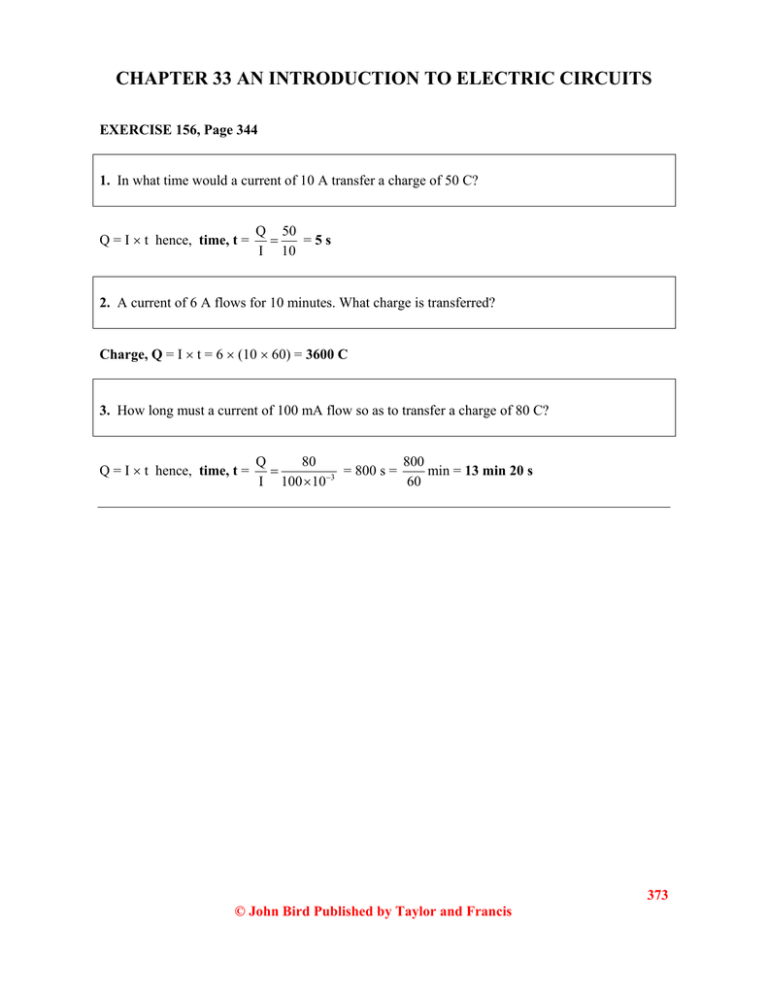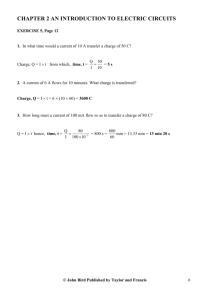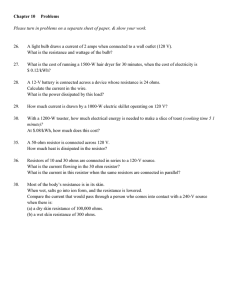CHAPTER 33 AN INTRODUCTION TO ELECTRIC CIRCUITS
advertisement

CHAPTER 33 AN INTRODUCTION TO ELECTRIC CIRCUITS EXERCISE 156, Page 344 1. In what time would a current of 10 A transfer a charge of 50 C? Q = I t hence, time, t = Q 50 =5s I 10 2. A current of 6 A flows for 10 minutes. What charge is transferred? Charge, Q = I t = 6 (10 60) = 3600 C 3. How long must a current of 100 mA flow so as to transfer a charge of 80 C? Q = I t hence, time, t = Q 80 800 min = 13 min 20 s = 800 s = 3 I 100 10 60 373 © John Bird Published by Taylor and Francis EXERCISE 157, Page 346 1. The current flowing through a heating element is 5 A when a p.d. of 35 V is applied across it. Find the resistance of the element. Resistance, R = V 35 =7Ω I 5 2. An electric light bulb of resistance 960 is connected to a 240 V supply. Determine the current flowing in the bulb. Current, I = V 240 1 = 0.25 A R 960 4 3. Graphs of current against voltage for two resistors P and Q are shown below. Determine the value of each resistor. For resistor P, R = V 16 V 16 106 V = 2 103 = 2 m 3 I 8 mA 8 10 A For resistor Q, R = V 20 V 20 106 V = 5 103 = 5 m 3 I 4 mA 4 10 A 374 © John Bird Published by Taylor and Francis 4. Determine the p.d. which must be applied to a 5 k resistor such that a current of 6 mA may flow. P.d., V = I R = 6 103 5 103 = 30 V 375 © John Bird Published by Taylor and Francis EXERCISE 158, Page 349 1. The hot resistance of a 250 V filament lamp is 625 . Determine the current taken by the lamp and its power rating. Current, I = V 250 = 0.4 A I 625 Power rating, P = V I = 250 0.4 = 100 W (or P = V 2 2502 = 100 W R 625 or P = I 2 R 0.4 625 = 100 W) 2 2. Determine the resistance of an electric fire which takes a current of 12 A from a 240 V supply. Find also the power rating of the fire and the energy used in 20 h. Resistance, R = V 240 = 20 I 12 Power rating, P = V I = 240 12 = 2880 W or 2.88 kW Energy = power time = 2.88 kW 20 h = 57.6 kWh 3. Determine the power dissipated when a current of 10 mA flows through an appliance having a resistance of 8 k. Power, P = I 2 R 10 103 8 103 = 0.8 W 2 4. 85.5 J of energy are converted into heat in nine seconds. What power is dissipated? Power, P = energy 85.5 J = 9.5 W time 9s 376 © John Bird Published by Taylor and Francis 5. A current of 4 A flows through a conductor and 10 W is dissipated. What p.d. exists across the ends of the conductor? Power, P = V I from which, p.d., V = P 10 = 2.5 V I 4 6. Find the power dissipated when: (a) a current of 5 mA flows through a resistance of 20 k (b) a voltage of 400 V is applied across a 120 k resistor (c) a voltage applied to a resistor is 10 kV and the current flow is 4 mA (a) Power, P = I 2 R 5 103 20 103 = 0.5 W 2 (b) Power, P = V2 4002 = 1.33 W R 120 103 (c) Power, P = V I = 10 103 4 103 = 40 W 7. A d.c. electric motor consumes 72 MJ when connected to 400 V supply for 2 h 30 min. Find the power rating of the motor and the current taken from the supply. energy 72 106 J Power = = 8000 W = 8 kW = power rating of motor time 2.5 60 60 P 8 103 Power, P = V I, hence, current, I = = 20 A V 400 8. A p.d. of 500 V is applied across the winding of an electric motor and the resistance of the winding is 50 . Determine the power dissipated by the coil. Power, P = V 2 5002 = 5000 W = 5 kW R 50 377 © John Bird Published by Taylor and Francis 9. In a household during a particular week three 2 kW fires are used on average 25 h each and eight 100 W light bulbs are used on average 35 h each. Determine the cost of electricity for the week if 1 unit of electricity costs 15p Energy in week = 3(2 kW 25 h) + 8( 100 103 kW 35 h) = 150 + 28 = 178 kWh Cost = 178 15 = 2670p = £26.70 10. Calculate the power dissipated by the element of an electric fire of resistance 30 when a current of 10 A flows in it. If the fire is on for 30 hours in a week determine the energy used. Determine also the weekly cost of energy if electricity costs 13.50p per unit. Power, P = I 2 R 10 30 = 3000 W or 3 kW 2 Energy = power time = 3 kW 30 h = 90 kWh Cost = 90 13.50p = 1215p = £12.15 378 © John Bird Published by Taylor and Francis EXERCISE 159, Page 350 1. A television set having a power rating of 120 W and electric lawnmower of power rating 1 kW are both connected to a 240 V supply. If 3 A, 5 A and 10 A fuses are available state which is the most appropriate for each appliance. Power, P = V I hence, current, I = For the television, I = P V P 120 = 0.5 A, hence the 3 A fuse is the most appropriate V 240 For the lawnmower, I = P 1000 = 4.17 A, hence the 5 A fuse is the most appropriate V 240 EXERCISE 160, Page 350 Answers found from within the text of the chapter, pages 341 to 350. EXERCISE 161, Page 351 1. (d) 13. (b) 2. (a) 3. (c) 4. (b) 14. (a) 15. (c) 5. (d) 6. (d) 7. (b) 16. (b) 17. (d) 18. (d) 8. (c) 9. (a) 10. (a) 11. (c) 12. (c) 379 © John Bird Published by Taylor and Francis



